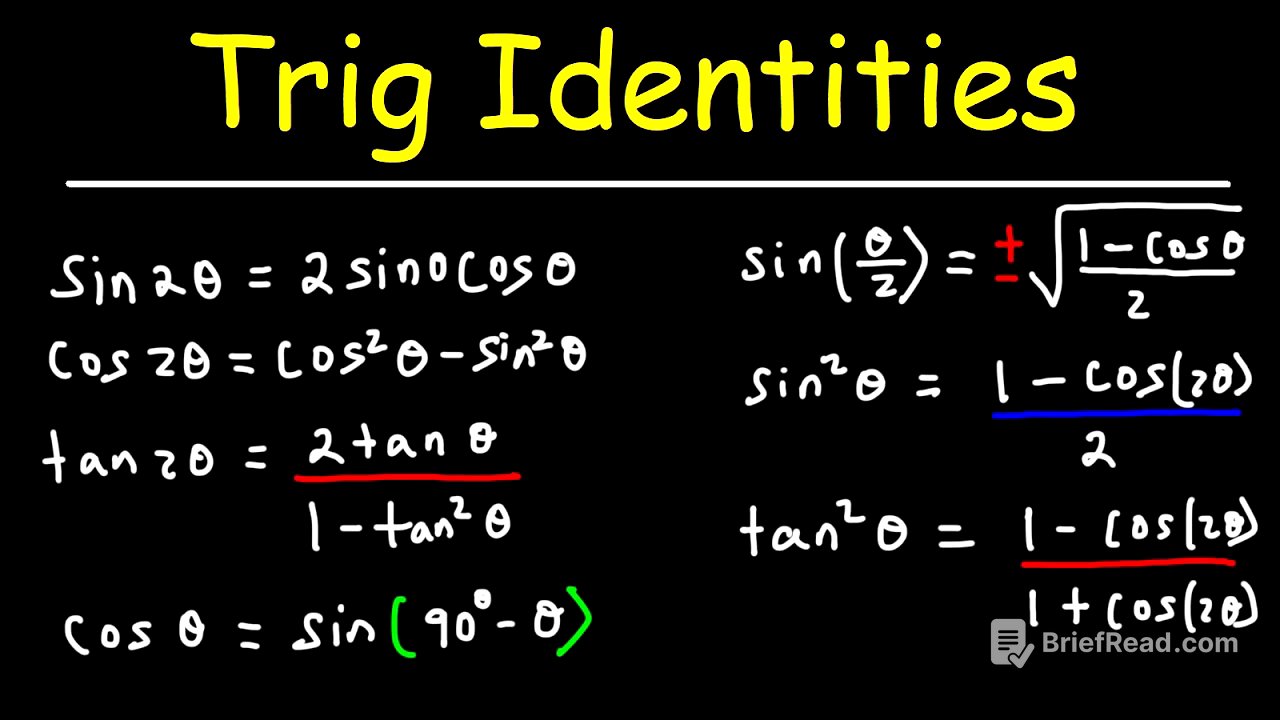TLDR;
This video provides a comprehensive overview of essential trigonometric identities, including trig ratios, reciprocal identities, quotient identities, Pythagorean identities, even and odd functions, cofunction identities, double and half angle identities, sum and difference identities, power reducing formulas, product to sum formulas, sum to product formulas, the Law of Sines, the Law of Cosines, the Law of Tangents, and formulas for calculating the area of a triangle. It's designed to help students whether they're just starting out or preparing for a final exam.
- Covers fundamental trig identities and formulas.
- Includes examples and explanations for each type of identity.
- Offers additional resources for practice problems.
Introduction to Trigonometric Identities [0:01]
The video introduces common trigonometric identities relevant to a trigonometry course, beneficial for both beginners and those preparing for final exams. It focuses on the essential formulas needed in trigonometry. The video starts by defining the sides of a right triangle in relation to an angle Theta: the opposite side, the adjacent side, and the hypotenuse.
Trigonometric Ratios: Sine, Cosine and Tangent [0:34]
The video explains the three primary trigonometric ratios using the acronym SOHCAHTOA. Sine (SOH) is defined as the Opposite side divided by the Hypotenuse. Cosine (CAH) is Adjacent over Hypotenuse. Tangent (TOA) is Opposite over Adjacent. These ratios are fundamental to understanding trigonometry.
Reciprocal Identities: Cosecant, Secant, and Cotangent [1:23]
The video details the reciprocal identities, starting with cosecant (csc θ) as the reciprocal of sine (1/sin θ). Secant (sec θ) is the reciprocal of cosine (1/cos θ), and cotangent (cot θ) is the reciprocal of tangent (1/tan θ). The video highlights the reversibility of these relationships, noting that if cosecant is 1/sine, then sine is also 1/cosecant, and similarly for secant/cosine and tangent/cotangent.
Example Problem: Finding Trigonometric Ratios [2:17]
The video presents an example using a 3-4-5 right triangle to find the six trigonometric ratios. It calculates sine as 4/5 (opposite over hypotenuse), cosine as 3/5 (adjacent over hypotenuse), and tangent as 4/3 (opposite over adjacent). It also introduces quotient identities, defining tangent as sine over cosine and cotangent as cosine over sine. The example then finds cosecant as 5/4 (reciprocal of sine), secant as 5/3 (reciprocal of cosine), and cotangent as 3/4 (reciprocal of tangent), reinforcing the reciprocal relationships.
Pythagorean Identities [3:57]
The video introduces the Pythagorean identities, beginning with the core identity: sin²θ + cos²θ = 1. It explains how dividing this identity by sin²θ yields 1 + cot²θ = csc²θ, and dividing by cos²θ gives tan²θ + 1 = sec²θ. These variations are crucial for solving trigonometric equations.
Even and Odd Functions [5:57]
The video discusses even and odd trigonometric functions. Sine, tangent, cosecant, and cotangent are odd functions, meaning that sin(-θ) = -sin(θ), tan(-θ) = -tan(θ), csc(-θ) = -csc(θ), and cot(-θ) = -cot(θ). Cosine and secant are even functions, so cos(-θ) = cos(θ) and sec(-θ) = sec(θ).
Cofunction Identities [7:55]
The video covers cofunction identities, starting with cos(θ) = sin(90° - θ) or cos(θ) = sin(π/2 - θ). It also states that sin(θ) = cos(90° - θ). Additionally, it notes that csc(θ) = sec(90° - θ), cot(θ) = tan(90° - θ), and tan(θ) = cot(90° - θ). The video explains that cofunctions are equivalent when their angles add up to 90 degrees, illustrating this with examples like cos(0°) = sin(90°) = 1 and cos(45°) = sin(45°) = √2/2.
Double Angle Identities [10:26]
The video explains double angle identities, starting with sin(2θ) = 2sin(θ)cos(θ). It then covers the multiple forms of cos(2θ): cos²(θ) - sin²(θ), 2cos²(θ) - 1, and 1 - 2sin²(θ). Finally, it introduces tan(2θ) = 2tan(θ) / (1 - tan²(θ)).
Half Angle Identities [11:32]
The video covers half-angle identities, beginning with sin(θ/2) = ±√((1 - cos(θ))/2) and cos(θ/2) = ±√((1 + cos(θ))/2). It notes the similarity between these formulas, with the sign determining the quadrant. It also presents multiple forms of tan(θ/2): √((1 - cos(θ))/(1 + cos(θ))), (1 - cos(θ))/sin(θ), and sin(θ)/(1 + cos(θ)), demonstrating how these forms can be derived from each other.
Deriving Alternative Forms of Half Angle Identities [13:11]
The video shows how to derive alternative forms of the half-angle identity for tangent. Starting with tan(θ/2) = √((1 - cos(θ))/(1 + cos(θ))), it multiplies the numerator and denominator by √(1 - cos(θ)) to get (1 - cos(θ))/sin(θ). Alternatively, multiplying by √(1 + cos(θ)) results in sin(θ)/(1 + cos(θ)). The video also revisits the double angle formula for cosine, showing how the forms cos²(θ) - sin²(θ), 2cos²(θ) - 1, and 1 - 2sin²(θ) are interchangeable using the Pythagorean identity.
Sum and Difference Identities [17:50]
The video details the sum and difference identities. For sine: sin(α ± β) = sin(α)cos(β) ± cos(α)sin(β), where the signs match. For cosine: cos(α ± β) = cos(α)cos(β) ∓ sin(α)sin(β), where the signs are opposite. For tangent: tan(α ± β) = (tan(α) ± tan(β)) / (1 ∓ tan(α)tan(β)), with matching signs in the numerator and opposite signs in the denominator.
Power Reducing Formulas [20:09]
The video explains power reducing formulas, which are used to reduce the power of trigonometric functions. It states that sin²(θ) = (1 - cos(2θ))/2, cos²(θ) = (1 + cos(2θ))/2, and tan²(θ) = (1 - cos(2θ))/(1 + cos(2θ)). The video notes that to reduce the power from square to the first power, the angle must be doubled.
Product to Sum Formulas [21:09]
The video lists the product-to-sum formulas: sin(α)sin(β) = (1/2)[cos(α - β) - cos(α + β)], cos(α)cos(β) = (1/2)[cos(α - β) + cos(α + β)], sin(α)cos(β) = (1/2)[sin(α + β) + sin(α - β)], and cos(α)sin(β) = (1/2)[sin(α + β) - sin(α - β)]. It suggests searching for specific examples on YouTube for further clarification.
Sum to Product Formulas [23:14]
The video presents the sum-to-product formulas: sin(α) + sin(β) = 2sin((α + β)/2)cos((α - β)/2), sin(α) - sin(β) = 2sin((α - β)/2)cos((α + β)/2), cos(α) + cos(β) = 2cos((α + β)/2)cos((α - β)/2), and cos(α) - cos(β) = -2sin((α + β)/2)sin((α - β)/2).
Law of Sines [24:42]
The video introduces the Law of Sines, which states that for any triangle, the ratio of the sine of an angle to the length of its opposite side is constant. Mathematically, this is expressed as sin(A)/a = sin(B)/b = sin(C)/c, where A, B, and C are the angles of the triangle, and a, b, and c are the lengths of the sides opposite those angles, respectively.
Law of Cosines [25:19]
The video explains the Law of Cosines, which is particularly useful when you have all three sides of a triangle but no angles. The formula is c² = a² + b² - 2ab cos(C), where c is the side opposite angle C, and a and b are the other two sides. Once one angle is found, the Law of Sines can be used to solve the rest of the triangle.
Area of a Triangle & Heron's Formula [25:57]
The video provides two methods for calculating the area of a triangle. The first method uses the formula: Area = (1/2)ab sin(C), where a and b are two sides of the triangle, and C is the angle between them. The second method is Heron's formula, which is Area = √(s(s - a)(s - b)(s - c)), where s is the semi-perimeter of the triangle, calculated as s = (a + b + c) / 2.
Law of Tangents [26:38]
The video briefly mentions the Law of Tangents, a less commonly used formula in trigonometry. It is expressed as (a - b) / (a + b) = tan((A - B) / 2) / tan((A + B) / 2), where a and b are sides of the triangle, and A and B are the angles opposite those sides. The video notes that this formula is more complicated compared to the Law of Sines and the Law of Cosines.
Conclusion [27:39]
The video concludes by summarising the trigonometric identities covered, noting their importance for trigonometry courses and final exam preparation. It encourages viewers to explore additional resources for practice problems.









